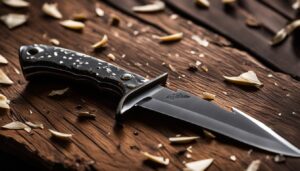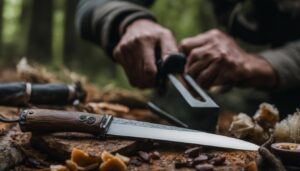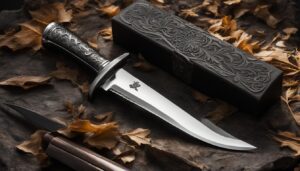As an outdoor enthusiast and avid hunter, I understand the importance of having a hunting knife that can withstand the rigors of the wilderness. When it comes to choosing a hunting knife, durability is key. A dependable blade can make all the difference in the field, ensuring that your knife remains sharp, reliable, and ready for any task.
Whether you’re skinning game, cutting through tough materials, or using your knife for self-defense, the durability of the blade is crucial. But how do you select a hunting knife with the right level of durability? Let’s dive into the factors to consider when choosing a hunting knife blade.
- Blade durability is essential for a hunting knife’s performance.
- Consider factors like the shape, type, and material of the blade.
- Handle design and tang also contribute to the overall durability.
- Choose the right size and type of knife for your specific needs.
- Blade material and design are crucial for durability and performance.
Factors to Consider When Choosing a Hunting Knife Blade
When selecting a hunting knife, the durability of the blade is a crucial factor to consider. The shape and type of blade play a significant role in determining the knife’s strength and longevity. Different blade designs offer distinct advantages for various hunting tasks. For example, a drop point blade provides excellent control and versatility, making it suitable for skinning and general use. On the other hand, a clip point blade offers a finer point, ideal for precision cutting and piercing tasks like field dressing game.
The material used in the blade is another critical consideration. Stainless steel and carbon steel are commonly used materials known for their durability and strength. Stainless steel is resistant to corrosion and requires less maintenance, making it a popular choice among hunters. Carbon steel, on the other hand, offers excellent hardness and edge retention, but it requires regular care to prevent rusting. Ultimately, the choice between stainless steel and carbon steel depends on the hunter’s preferences, maintenance capabilities, and the conditions in which the knife will be used.
In addition to the blade, other factors contribute to the overall durability of a hunting knife. The handle material and design are essential considerations. A durable handle material, such as rubber or textured synthetic materials, provides a secure grip, even in wet or cold conditions. The handle should also have ergonomic features, ensuring comfort during extended use. Furthermore, a finger stop or guard prevents hand slippage and enhances safety when handling the knife.
Lastly, the tang of the hunting knife is a crucial component that affects its durability. A full tang knife, where the blade extends through the handle, provides superior strength and stability. This design ensures that the handle and blade remain securely attached, even under heavy use or when applying significant force. A partial tang or rat-tail tang knife may be less durable and prone to breakage, making them less suitable for demanding hunting tasks.
Table: Comparison of Blade Materials
| Blade Material | Durability | Corrosion Resistance | Edge Retention |
|---|---|---|---|
| Stainless Steel | High | High | Moderate |
| Carbon Steel | High | Moderate | High |
Table: This table compares the durability, corrosion resistance, and edge retention of stainless steel and carbon steel, two commonly used blade materials in hunting knives. Both materials offer high durability, but stainless steel excels in corrosion resistance, while carbon steel has better edge retention. Hunters can choose based on their specific preference for maintenance and environmental conditions.
Choosing the Right Size and Type of Hunting Knife
When selecting a hunting knife, it is essential to consider the right size and type that suits your specific needs and preferences. While larger knives may seem impressive, they may not always be practical for every hunting task. Understanding the intended use of the knife, whether it’s for skinning, field dressing, or general purposes, will help determine the most suitable size and type.
Folding knives offer convenience and portability, making them a popular choice among outdoor enthusiasts. These knives can easily fit into a pocket or backpack and are ideal for everyday carry. However, they may not provide the same strength and durability as fixed-blade knives.
Fixed-blade knives, on the other hand, are known for their strength and reliability. With no moving parts, they can withstand heavy-duty tasks and are less likely to break under pressure. These knives are commonly used by hunters for field dressing and other demanding outdoor activities.
Key Considerations:
- Intended Use: Determine the primary purpose of the knife to choose the appropriate size and type.
- Portability: Consider the convenience of carrying a folding knife versus the reliability of a fixed-blade knife.
- Strength and Durability: Assess the tasks you will be performing and select a knife that can withstand those demands.

By carefully considering the size and type of hunting knife that best suits your needs, you can ensure that you have a reliable tool by your side during your outdoor adventures. Remember to evaluate the intended use, portability, strength, and durability of the knife to make an informed decision.
| Size | Type | Pros | Cons |
|---|---|---|---|
| Small | Folding | Easy to carry, convenient for everyday use | May lack the strength and durability of fixed-blade knives |
| Medium | Fixed-blade | Strong, reliable, suitable for various outdoor tasks | Less portable and may require a sheath for carrying |
| Large | Fixed-blade | Offers maximum strength and versatility | Can be bulky and less practical for certain tasks |
Blade Material and Design for Durability
When it comes to the durability of a hunting knife, the blade material and design are of utmost importance. The choice of blade material can greatly impact the strength, longevity, and overall performance of the knife. Stainless steel and carbon steel are among the most commonly used materials for hunting knife blades.
Stainless steel is known for its excellent resistance to corrosion, making it ideal for use in outdoor and wet environments. It is also relatively easy to maintain and clean. However, carbon steel blades tend to be tougher and have better edge retention, which is crucial for heavy-duty tasks such as skinning and field dressing. Carbon steel blades may require more maintenance to prevent rusting, but their durability and performance make them a popular choice among experienced hunters.
“The choice of blade material can greatly impact the strength, longevity, and overall performance of the knife.”
The blade design is another factor to consider when looking for durability in a hunting knife. Different blade designs offer varying advantages for specific hunting tasks. The drop point blade design, characterized by a curved spine and a sharp point, is versatile and suitable for a wide range of tasks, including slicing and piercing. On the other hand, the clip point blade design features a well-defined point that is ideal for detailed cutting and precision work.
Blade Material Comparison
| Blade Material | Advantages | Disadvantages |
|---|---|---|
| Stainless Steel | Excellent corrosion resistance | May be less durable and have lower edge retention compared to carbon steel |
| Carbon Steel | Superior toughness and edge retention | Requires more maintenance to prevent rusting |
When choosing a hunting knife, it’s crucial to consider the blade material and design that best suits your needs and hunting style. Whether you prioritize corrosion resistance, edge retention, or toughness, selecting the right blade material and design will ensure a durable and reliable hunting knife that can withstand the rigors of outdoor adventures.
With the right blade material and design, you can trust that your hunting knife will be up to the task, providing you with a durable and long-lasting tool that will serve you well in the field.
Handle Material and Design for Durability
When it comes to the durability of a hunting knife, the handle material and design play a crucial role. A sturdy handle ensures a secure grip and enhances overall knife performance. Let’s explore some key factors to consider:
Ergonomic Design and Finger Stop
Opting for a hunting knife with an ergonomic handle design is essential for long-lasting comfort and control. The handle should be shaped to fit your hand comfortably, reducing strain during extended use. Additionally, look for a finger stop or guard to prevent your hand from slipping onto the blade, ensuring your safety while handling the knife.
Durable Materials for a Secure Grip
The handle material should be chosen with durability in mind. Rubber or textured synthetic materials offer excellent grip even in wet or cold conditions, making them ideal for hunting in various environments. These materials are not only durable but also provide a secure and reliable grip, allowing you to handle the knife with confidence.
Overall, selecting a hunting knife with a handle that combines ergonomic design and durable materials enhances both safety and performance, ensuring that your knife remains sturdy and reliable throughout your outdoor adventures.


Conclusion
After considering all the factors discussed in this guide, it is evident that choosing a hunting knife with durability in mind is essential for any outdoor adventure. The blade material, design, handle material, and design all play crucial roles in determining the overall durability and performance of the knife.
When selecting a hunting knife, it is important to prioritize the longevity of the blade. Look for materials like stainless steel or carbon steel, as they offer excellent strength and edge retention. Consider the different blade designs available, such as drop point, clip point, and skinning blades, to find one that suits your specific hunting tasks.
The handle material and design are equally important for a durable hunting knife. Opt for materials like rubber or textured synthetic materials that provide a secure grip, even in wet or cold conditions. Ensure the handle has ergonomic features and a finger stop or guard to prevent hand slippage during use.
By carefully considering your specific needs and preferences when selecting a hunting knife, you can ensure that it will withstand the rigors of hunting and outdoor activities. Choose a dependable and long-lasting knife, and you will be well-prepared for any hunting or outdoor adventure that comes your way.
FAQ
What factors should I consider when choosing a hunting knife blade?
Factors to consider when choosing a hunting knife blade include the shape and type of blade, the material used, and the handle design and tang.
What types of blade designs are commonly used in hunting knives?
Common blade designs in hunting knives include drop point, clip point, and skinning blades, each offering advantages for specific hunting tasks.
What materials are commonly used for hunting knife blades?
Stainless steel and carbon steel are commonly used materials for hunting knife blades, offering excellent strength and edge retention.
What role does the handle material play in the durability of a hunting knife?
The handle material contributes to the overall durability of a hunting knife, with materials like rubber or textured synthetic materials providing a secure grip in various conditions.
Are folding knives or fixed-blade knives more durable?
Both folding knives and fixed-blade knives can be durable, but fixed-blade knives generally offer more strength and durability due to their design.
What size and type of hunting knife should I choose?
The size and type of hunting knife you choose should depend on your specific needs and preferences, considering factors like intended use and portability.





